from Barton Gold Holdings Limited (isin : AU0000153215)
Tarcoola Mineral Resources Update (Perseverance Mine)
~20koz Au shallow Mineral Resources with further extension potential
ADELAIDE, AUSTRALIA / ACCESSWIRE / July 2, 2024 / Barton Gold Holdings Limited
HIGHLIGHTS
Tarcoola JORC (2012) Mineral Resources increased to ~20koz @ ~2 g/t Au at Perseverance
Resources within 60 - 80 metres of open pit floor, with potential depth / strike extensions
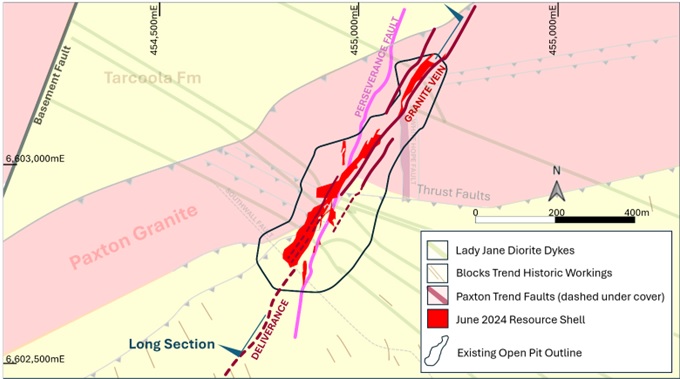
Barton Gold Holdings Limited (ASX:BGD),(FRA:BGD3),(OTCQB:BGDFF) ( Barton or Company ) is pleased to confirm an updated Mineral Resources Estimate for its South Australian Tarcoola Gold Project ( Tarcoola ).
Approximately 1,688m of recent Barton drilling has delivered an updated JORC (2012) Mineral Resources Estimate (MRE) of 19.9koz Au within 60 - 80m of the Perseverance Mine open pit floor. The total Tarcoola MRE is now 29.5koz Au (0.54Mt @ 1.70 g/t Au) , with ~45% classified as ‘Indicated' category, including 9.6koz Au contained in lower-grade existing stockpiles next to the Perseverance Mine.
Commenting on the Perseverance Mine's JORC MRE update, Barton MD Alex Scanlon said:
"This is an excellent starting point for the second phase of our regional strategy. Tarcoola now holds ~530,000 tonnes of JORC Resources in stockpiles and in the pit floor, with potential extensions, on an existing Mining Lease.
"With an existing fully permitted mill, even minor pit extensions can offer high-value ounces. We plan to continue incrementally building these Resources while testing priority regional targets for new Tarcoola mineralisation."
Background & Recent Drilling
The historical Tarcoola Goldfield produced ~77koz Au at an average grade of ~37.5 g/t during 1893 - 1955 from shallow workings on Barton's Mining Lease 6455, and a small open pit mine (Perseverance) produced ore grading 2 - 4 g/t Au to Barton's Central Gawler Mill during 2016 - 2018. [1] Notwithstanding this ~130 year history, relatively little has been historically invested to evaluate the goldfield's architecture or locating prospective ‘repeats' of shallow, high-grade mineralisation in the surrounding area.
Barton's regional development strategy is to establish large-scale, bulk open pit mineralisation combined with nearby higher-grade blending feed to realise the benefits of economies of scale, and to potentially support an early ‘Stage 1' operation leveraging the existing Central Gawler Mill to process these materials.
Barton has rapidly grown the neighbouring Tunkillia Gold Project ( Tunkillia ) to a JORC MRE of 1.5Moz Au (51.3Mt @ 0.91 g/t Au) over the past two years. [2] A preliminary Scoping Study is now underway to test a prospective 5Mtpa processing model, and to identify key cost drivers for subsequent optimisation.
Barton is now evaluating the Tarcoola Goldfield for potential higher-grade mineralisation. In December 2023 and April 2024 Barton drilled 1,688m (26 holes) in the Perseverance pit floor, confirming high-grade extensions of pit floor mineralisation grading up to ~12 g/t Au, and new structures below the open pit. [3]
Barton has remodelled the open pit mineralisation to include these recent drilling results, and has also identified extensions for additional investigation and further potential JORC MRE growth.
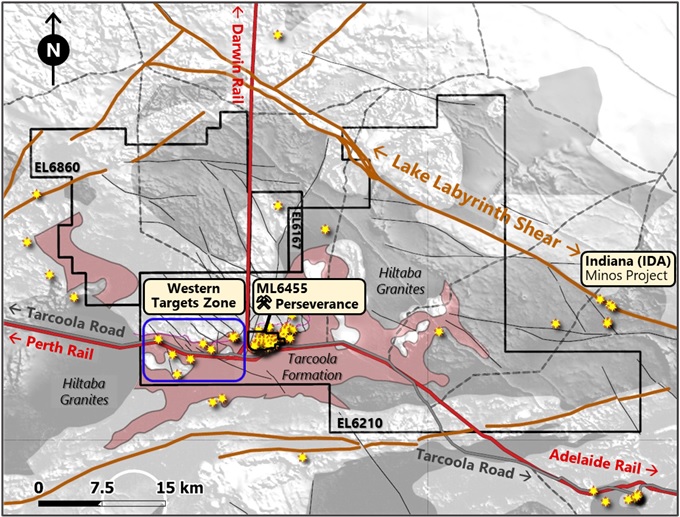
Updated Tarcoola Block Model & MRE
Updated modelling shows two key areas where mineralisation has been converted to an updated JORC MRE in the north and central open pit floor areas. The updated MRE has been estimated to 25mRL only, with all JORC Resources within 60 - 80 metres of the southern and northern pit floor areas (respectively).
Mineralisation also extends below the new MRE, and into the Deliverance zone south of the pit (see Figure 3). These areas are not yet JORC classified and present opportunities for further drilling and MRE growth.
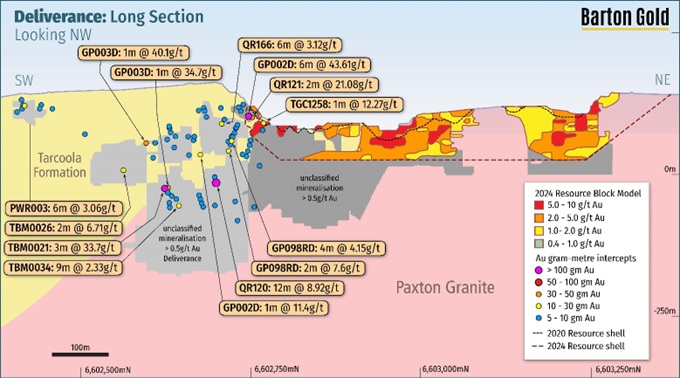
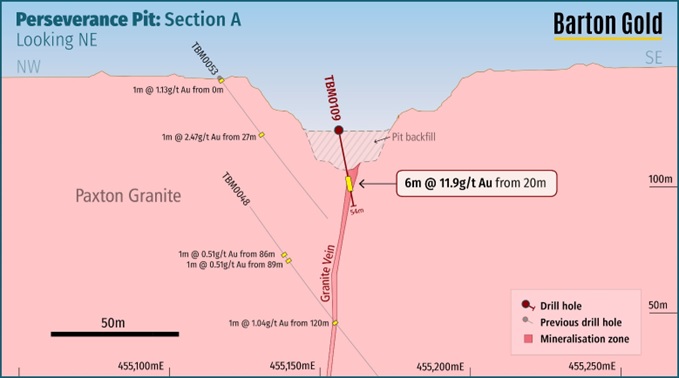
Updated Tarcoola JORC MRE Statement
The Tarcoola JORC MRE was last estimated during November 2020. [5]
Further to the updated Perseverance Mine JORC MRE detailed in this announcement, Tarcoola's overall Mineral Resource endowment has grown by ~87% to a total 29.5koz Au (0.54Mt @ 1.70 g/t Au).
The updated Tarcoola JORC MRE (as at June 2024) is shown below at Table 1.
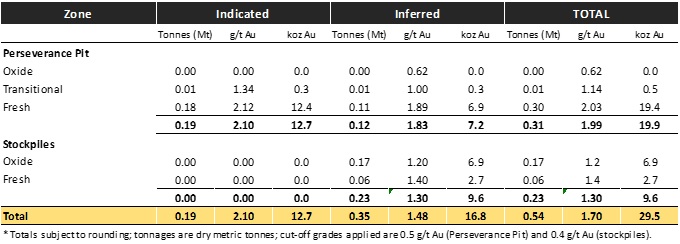
Table 1 - Tarcoola MRE (June 2024)
The previously reported Tarcoola MRE (as at November 2020) is shown below at Table 2.

Table 2 - Tarcoola MRE (November 2020) 9
Ongoing Tarcoola Goldfield Drilling
Barton's December 2023 and April 2024 drilling program was the first since the Company published a new regional architectural map of the Tarcoola Goldfield following two years of geophysical investigation in parallel with its Tunkillia growth drilling programs. [6]
This modelling has identified multiple local structures analogous to the structure which hosts the Perseverance Mine and is the first time in the ~130 year history of the Tarcoola Goldfield that all known historical gold occurrences can be put into a consistent structure framework.
Following the completion of open pit drilling at the Perseverance Mine, Barton commenced a ~7,000m reverse circulation ( RC ) drilling program as a preliminary test of multiple interpreted priority targets, including Tolmer, Mulgathing and Warburton. [7]
The objective of this program is to test for the existence of interpreted structures, validate and refine new methodologies and techniques that Barton is developing for exploration under cover in the region, and to define a new regional structural model. Barton also hopes to identify new potential sources of higher-grade mineralisation similar to that produced in the area of and surrounding the Perseverance Mine.
This program was subsequently expanded to ~9,000m and remains ongoing. The program is anticipated to complete during July 2024. Certain priority samples dispatched to Barton lab services provider for fire assay analyses and Barton expects to publish the results of all drilling during July and August 2024. [8]
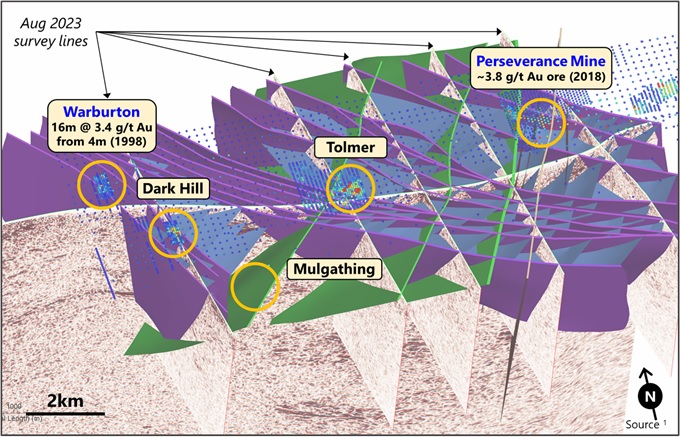
Updated Global Barton JORC MRE Statement
Further to the updated MRE detailed in this announcement for the Perseverance Mine, Barton's total attributable JORC (2012) Mineral Resource endowment has grown by approximately 1% to a total 1,588koz Au (52.3Mt @ 0.94 g/t Au). Table 3 below provides the full details of Barton's global MRE endowment.
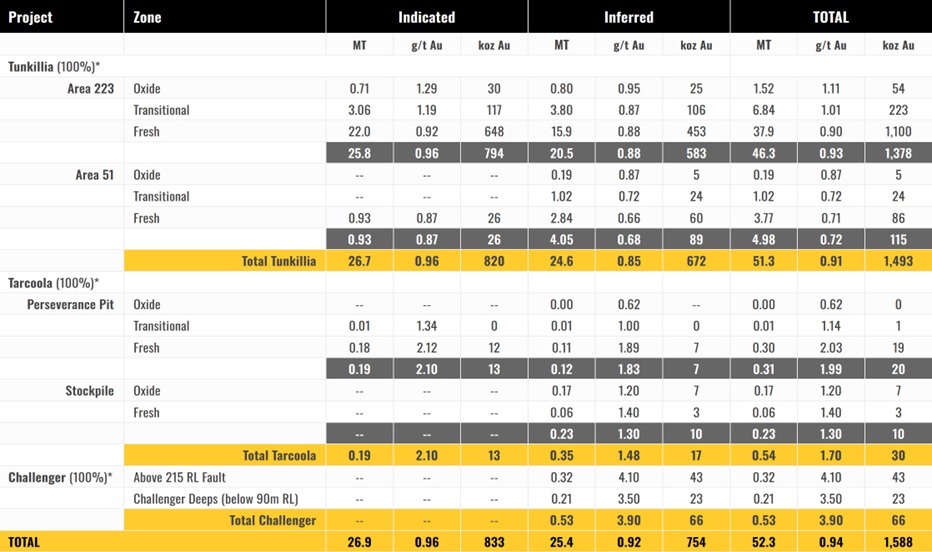
Table 3 - Barton Global JORC MRE Inventory (June 2024)
Mineral Resource Estimation Methodology and Data
The following summary information is provided in accordance with ASX Listing Rule 5.8.1. Further detail is provided in the attached JORC Table 1.
Summary
The Tarcoola Project is located 70 km NNW of Barton Gold's Tunkillia Project in South Australia, and comprises ~1,640km2 of tenements, including the open pit Perseverance Mine at the brownfields Perseverance Deposit. The mine, which operated during 2017 and 2018, is held within Mineral Lease (ML) 6455 located 3 km west of the Tarcoola Rail Siding in South Australia's Gawler Craton. The Tarcoola Project is 100% owned by Tunkillia 2 Pty Ltd which is a wholly owned subsidiary of Barton Gold Holdings Limited.
The Tarcoola Project lies within the north-western Gawler Craton, and centred over the historic Tarcoola goldfield where Archaean and Proterozoic rocks form the basement to an extensive cover of Phanerozoic sediments. Gold mineralisation is hosted within the sedimentary Tarcoola Formation and the Paxton Granite, both of Proterozoic age. A suite of later intrusions (Lady Jane Diorite) cut both the sedimentary rocks and the granite.
The resource is reported above a depth of 25 m RL and above a 0.5 g/t gold cut off. 25 m RL is approximately 125 m below the surface and 60 m below the pit floor.

Mineral Resources are not Ore Reserves and do not have demonstrated economic viability. Inferred Resources have less geological confidence than Indicated Resources and should not have modifying factors applied to them. It is reasonable to expect that with further exploration most of the Inferred Resources could be upgraded to Indicated Resources.
Geology and geological interpretation
The Tarcoola Project lies within the north-western Gawler Craton, centred over the historic Tarcoola Goldfield, where Archaean and Proterozoic rocks form the basement to an extensive cover of Phanerozoic sediments. The Archaean basement has been extensively deformed, whereas the Proterozoic rocks have been weakly to moderately deformed.
At the Perseverance Deposit, gold mineralisation is controlled by a sub-vertical NE-NNE trending fault zone within the sedimentary rocks of the Tarcoola Formation and the Paxton Granite, both of Proterozoic age. A suite of later intrusions (Lady Jane Diorite) cut both the sedimentary rocks and the granite. These high level mafic intrusives are associated with the 1590 Ma Hiltaba Magmatic Event, and are considered to control the spatial setting of both gold and base metal mineralisation.
Gold has locally been remobilised and enriched in the weathering profile. The base of complete oxidation occurs typically 10-40 m below surface, and the base of partial oxidation occurs at a depth of 20-60 m.
Within the primary zone, sericite-quartz-pyrite alteration zones are spatially associated with the mineralisation and overprint earlier hematite-magnetite alteration. An outer halo of chlorite (+/- leucoxene and pyrite) is developed. Pyrite, galena and sphalerite are the main associated sulphide minerals, with subordinate amounts of chalcopyrite, bornite and/or arsenopyrite noted.
Veins can be discrete or form wider stockwork zones and are surrounded by broader quartz-sericite alteration envelopes, which can host haloes of lower grade background mineralisation. Dispersed supergene mineralisation in the oxide zone can be largely detached from veining.
The Perseverance Deposit extends over approximately 500 m from the Southwall Fault to include Last Resource north of the White Hope Fault. Mineralisation has been identified south of Southwall Fault but is not considered in this mineral resource estimate.
Drilling techniques
A total of 694 RC and diamond drill holes for 77,250 m have been drilled within the area defined by the Tarcoola mineral resource. 694 of these holes are RC (45,468 m), with 50 holes (7,386 m) being either diamond or pre-collared diamond and 986 short RC grade control holes (24,395 m). Barton Gold's drilling since 2020 comprises 4,239 m of RC drilling (42 holes). The Barton Gold RC drilling was undertaken by Egan Drilling using a track mounted Sandvik 400 series with an on-board compressor and an auxiliary booster to provide approximately 2000 cfm ay 1000psi. The drill rig utilised a down hole hammer with a 5 ¾" face sampling bit.
Drill holes across the deposit are spaced at nominal 40 m x 40 m centres, with the mined-out areas drilled with grade control drilling on 5 m centres. Drill programmes are orientated perpendicular to strike and on east-west sections, although some grade control holes are drilled on north-south sections. Pierce points below the pit are commonly on 40 m sections.
The locations of historical drill holes have been verified by Barton Gold with both surface drill collar pick-ups and by validation of existing mineralisation with recent infill drilling.
Sampling and sub-sampling techniques
RC drilling by Barton Gold utilised a 5 ¾" face-sampling hammer, with a rig-mounted cone splitter attached to the cyclone providing one-metre sample intervals. Field duplicates were collected at a ratio of 1:30.
Sample analysis
Two to four kilogram RC splits and half-drill core were sent to Bureau Veritas in Adelaide for preparation and analysis using 40 g fire assay techniques for gold. Bureau Veritas' FA1 method uses a 40 g lead collection fire assay with AAS finish to a 0.01 ppm detection limit. Samples from an earlier phase of Barton Gold drilling were sent to Intertek Genalysis in Adelaide for preparation and analysis using 50 g fire assay techniques for gold and ICPOES/MS for multielement geochemistry.
A variety of analytical techniques and laboratories have been utilised over the course of the project's history and are considered suitable for resource estimation purposes.
QAQC
Barton Gold inserted certified reference materials (CRM's) supplied by OREAS into the sampling sequence every 50 samples. CRM's were selected on the basis of gold levels relevant to the deposit being drilled. Barton Gold's overall QAQC protocols utilised CRM's, field duplicates and certified coarse blanks inserted at an overall ratio of 1:44 routine drill hole samples for the RC drill program.
Based on the results of Barton's QA/QC analysis, in addition to the internal QA/QC standards, repeats and blanks run by the laboratory, the laboratory was deemed to provide an acceptable level of accuracy and precision.
Estimation methodology
The geological interpretations are based on pit mapping and drill hole data. Drill core and RC chip logging has been used to define the main geological units and weathering profile boundaries.
Mineralisation above the base of weathering is assumed to be affected by supergene or weathering effects and is interpreted as having been dominantly mined out. Eleven fresh rock mineralised structures were interpreted, based on continuity of grade at a lower cut-off of 0.8 g/t Au at the Perseverance Deposit. Three mineralised structures were orientated along the Perseverance Fault and seven were interpreted to strike N-NNW. Structures were grouped into geostatistical domains based on grade similarities and structural orientation.
Several small mafic dykes (Lady Jane Diorites) cross-cut the deposit. The northwest and northeast trending dykes appear to control narrow mineralised zones along the contacts. Due to their small volume and associated mineralisation the Lady Jane Diorites were not depleted from the mineral resource estimate.
The Mineral Resource statement reported herein is a reasonable representation of the Tarcoola Project's Perseverance Deposit, based on pit exposures and current sampling data. Grade estimation was undertaken using Geovia's Surpac™ software package (v7.7.2). Ordinary Kriging ("OK") was selected for grade estimation.
The block model utilises parent blocks measuring 10 m x 20 m x 5 m with sub-blocking to 0.625 x 2.5 x 1.25 m (XYZ) to better define the volumes. Blocks above topography are flagged as air blocks. Estimation resolution was set at the parent block size.
Informing samples were composited down hole to one metre intervals. Grade capping was applied to outlier composites. Experimental variograms were generated where possible in Supervisor, (no transformations were attempted). For domains where experimental variograms could not be created, the variogram models were orientated along strike and down dip, composite data was viewed in three dimensions to determine if a plunge should be incorporated into the variogram. A two-pass estimation process was employed, with the first pass (60 m search) requiring a minimum of either 4 or 8 composites and a maximum of between 8 and 12 composites depending on the size of the domain. The second pass (120 m search) reduced the minimum composites required by half and the maximum of composites required by four-fifths. Density values are assigned to blocks based on lithology and weathering; the average density of the mineralisation is 2.64 t/m3.
Block model validation consisted of visual checks in plan and section, global comparisons between input and output means and alternative estimation techniques.
Cut-off grades
The Mineral Resource is reported above a 0.5 g/t gold grade and within 125 m of the surface (25 m RL), approximately 60 m below the pit floor. The following assumptions were considered.
Resource Cut Off Assumptions | ||
Item | Units | Value |
Gold Price | AUD$/oz | $3,000 |
Gold Price | AUD$/g | $ 96.45 |
Recovery | % | 95% |
Effective Revenue | AUD$/g | $ 91.63 |
Less Royalty | % | 6.0% |
Less per g Costs | AUD$/g | $ 1.20 |
Realised Revenue | AUD$/g | $ 84.93 |
Cost to Mine/t ore | AUD$/t | $ 14.59 |
Costs to Process (+G&A) | AUD$/t | $ 27.95 |
Cut-off (in place) | g/t | 0.50 |
Dilution | % | 5% |
Resource Cut-off Grade | g/t | 0.53 |
Criteria used for classification
The Resource Estimates were classified in accordance with the JORC 2012 code. The Tarcoola resources (Perseverance Deposit) are classified based on data quality, drill density, number of informing samples, kriging efficiency, average distance to informing samples and vein consistency (geological continuity). Geological continuity has been demonstrated at 40 m grid spacing over the entire strike of the deposits. Short range variability has been established with grade control drilling (5 to 10 m spacing) in mined out areas, with grade control drilling extending up to 30 m below the pit floor in the better proportion of the deposit. Areas drilled with at least 20 m sections and including tighter infill drilling may be classified as indicated, predicated on geological confidence. Areas of 40 m x 40 m or greater have been classified as inferred. Areas of limited geological confidence or at a depth beyond a reasonable open pit depth remain unclassified. A Mineral Resource is not an Ore Reserve and does not have demonstrated economic viability.
Mining and metallurgical methods and parameters and other material modifying factors considered to data
Barton Gold foresees mining via open pit and conventional grinding and leach recovery. The Competent Person notes that this is a reasonable assumption but should not be regarded as rigorous at this stage of the project. The current Mineral Resource does not include any dilution or ore loss associated with practical mining constraints. The Tarcoola mineralisation sampled has been shown to be amenable to direct cyanidation for gold extraction. The Perseverance Deposit was processed at the Challenger CIL plant between 2017 and 2018. Metallurgical work (1988, 1998 and 2013) show good recoveries between 95 and 98% on P80 75µ oxidised and fresh material.
Authorised by the Board of Directors of Barton Gold Holdings Limited.
For further information, please contact:
Alexander Scanlon | Shannon Coates |
Competent Persons Statements
The information in this announcement that relates to Exploration Results for the Tarcoola Gold Project (including drilling, sampling, geophysical surveys and geological interpretation) is based upon, and fairly represents, information and supporting documentation compiled by Mr Marc Twining BSc (Hons). Mr Twining is an employee of Barton Gold Holdings Ltd and is a Member of the Australasian Institute of Mining and Metallurgy Geoscientists (AusIMM Member 112811) and has sufficient experience with the style of mineralisation, the deposit type under consideration and to the activity being undertaken, to qualify as a Competent Person as defined in the 2012 Edition of the "Australasian Code for Reporting of Exploration Results, Mineral Resources and Ore Reserves" (The JORC Code). Mr Twining consents to the inclusion in this announcement of the matters based upon this information in the form and context in which it appears.
The information in this announcement that relates to the estimate of open pit Mineral Resources for the Tarcoola Gold Project geological interpretation and resource estimates) is based upon, and fairly represents, information and supporting documentation compiled by Mr Ian Taylor BSc (Hons). Mr Taylor is an employee of Mining Associates Pty Ltd and has acted as an independent consultant on Barton Gold's Tarcoola Gold Project, South Australia. Mr Taylor is a Fellow and certified Professional of the Australian Institute of Mining and Metallurgy (FAusIMM (CP Geo) 110090) and has sufficient experience with the style of mineralisation, the deposit type under consideration and to the activity being undertaken, to qualify as a Competent Person as defined in the 2012 Edition of the "Australasian Code for Reporting of Exploration Results, Mineral Resources and Ore Reserves" (The JORC Code). Mr Taylor consents to the inclusion in this announcement of the matters based upon this information in the form and context in which it appears.
The information in this announcement that relates to the estimate of stockpile Mineral Resources for the Tarcoola Project is based upon, and fairly represents, information and supporting documentation compiled by Dr Andrew Fowler MAusIMM CP (Geo). Dr Fowler is an employee of Mining Plus Pty Ltd and has acted as an independent consultant on Barton Gold's Tarcoola Project, South Australia. Dr Fowler is a Member of the Australian Institute of Mining and Metallurgy (AusIMM) and has sufficient experience with the style of mineralisation, the deposit type under consideration and to the activity being undertaken, to qualify as a Competent Person as defined in the 2012 Edition of the "Australasian Code for Reporting of Exploration Results, Mineral Resources and Ore Reserves" (The JORC Code). The Company confirms it is not aware of any new information or data that materially affects the information included in the relevant market announcement and in the case of estimates of mineral resources all material assumptions and technical parameters underpinning the estimates in the relevant market announcement continue to apply and have not materially changed.
About Barton Gold
Barton Gold is an ASX, OTCQB and Frankfurt Stock Exchange listed Australian gold developer targeting future gold production of 150,000oz annually, with ~1.6Moz Au JORC Mineral Resources (52.3Mt @ 0.94 g/t Au), multiple advanced exploration projects and brownfield mines, and 100% ownership of the only regional gold mill in the renowned central Gawler Craton of South Australia. *
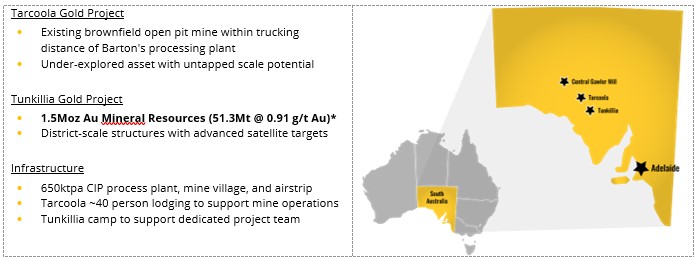
Competent Persons Statement & Previously Reported Information
The information in this announcement that relates to the historic Exploration Results and Mineral Resources as listed in the table below is based on, and fairly represents, information and supporting documentation prepared by the Competent Person whose name appears in the same row, who is an employee of or independent consultant to the Company and is a Member or Fellow of the Australasian Institute of Mining and Metallurgy (AusIMM), Australian Institute of Geoscientists (AIG) or a Recognised Professional Organisation (RPO). Each person named in the table below has sufficient experience which is relevant to the style of mineralisation and types of deposits under consideration and to the activity which he has undertaken to quality as a Competent Person as defined in the JORC Code 2012 ( JORC ).
Activity | Competent Person | Membership | Status |
Tarcoola Mineral Resource (Stockpiles) | Dr Andrew Fowler (Consultant) | AusIMM | Member |
Tarcoola Mineral Resource (Perseverance Mine) | Mr Ian Taylor (Consultant) | AusIMM | Fellow |
Tarcoola Exploration Results (until 15 Nov 2021) | Mr Colin Skidmore (Consultant) | AIG | Member |
Tarcoola Exploration Results (after 15 Nov 2021) | Mr Marc Twining (Employee) | AusIMM | Member |
Tunkillia Exploration Results (until 15 Nov 2021) | Mr Colin Skidmore (Consultant) | AIG | Member |
Tunkillia Exploration Results (after 15 Nov 2021) | Mr Marc Twining (Employee) | AusIMM | Member |
Tunkillia Mineral Resource | Mr Ian Taylor (Consultant) | AusIMM | Fellow |
Challenger Mineral Resource | Mr Dale Sims (Consultant) | AusIMM / AIG | Fellow / Member |
The information relating to historic Exploration Results and Mineral Resources in this announcement is extracted from the Company's Prospectus dated 14 May 2021 or as otherwise noted in this announcement, available from the Company's website at www.bartongold.com.au or on the ASX website www.asx.com.au . The Company confirms that it is not aware of any new information or data that materially affects the Exploration Results and Mineral Resource information included in previous announcements and, in the case of estimates of Mineral Resources, that all material assumptions and technical parameters underpinning the estimates in the Prospectus continue to apply and have not materially changed. The Company confirms that the form and context in which the applicable Competent Persons' findings are presented have not been materially modified from the previous announcements.
Cautionary Statement Regarding Forward-Looking Information
This document may contain forward-looking statements. Forward-looking statements are often, but not always, identified by the use of words such as "seek", "anticipate", "believe", "plan", "expect", "target" and "intend" and statements than an event or result "may", "will", "should", "would", "could", or "might" occur or be achieved and other similar expressions. Forward-looking information is subject to business, legal and economic risks and uncertainties and other factors that could cause actual results to differ materially from those contained in forward-looking statements. Such factors include, among other things, risks relating to property interests, the global economic climate, commodity prices, sovereign and legal risks, and environmental risks. Forward-looking statements are based upon estimates and opinions at the date the statements are made. Barton undertakes no obligation to update these forward-looking statements for events or circumstances that occur subsequent to such dates or to update or keep current any of the information contained herein. Any estimates or projections as to events that may occur in the future (including projections of revenue, expense, net income and performance) are based upon the best judgment of Barton from information available as of the date of this document. There is no guarantee that any of these estimates or projections will be achieved. Actual results will vary from the projections and such variations may be material. Nothing contained herein is, or shall be relied upon as, a promise or representation as to the past or future. Any reliance placed by the reader on this document, or on any forward-looking statement contained in or referred to in this document will be solely at the readers own risk, and readers are cautioned not to place undue reliance on forward-looking statements due to the inherent uncertainty thereof.
JORC Table 1 - Tarcoola Gold Project
Section 1 Sampling Techniques and Data
Criteria | Commentary |
|---|---|
Sampling techniques Nature and quality of sampling (e.g. cut channels, random chips, or specific specialised industry standard measurement tools appropriate to the minerals under investigation, such as down hole gamma sondes, or handheld XRF instruments, etc.). These examples should not be taken as limiting the broad meaning of sampling. Include reference to measures taken to ensure sample representivity and the appropriate calibration of any measurement tools or systems used. Aspects of the determination of mineralisation that are Material to the Public Report. In cases where ‘industry standard' work has been done this would be relatively simple (e.g. "RC drilling was used to obtain 1 m samples from which 3 kg was pulverised to produce a 30 g charge for fire assay"). In other cases, more explanation may be required, such as where there is coarse gold that has inherent sampling problems. Unusual commodities or mineralisation types (e.g. submarine nodules) may warrant disclosure of detailed information | Sampling during Barton Gold's RC drill programs at Tarcoola was obtained through reverse circulation (RC) and diamond drilling methods. Historic RC and diamond drilling methods were also used in drilling campaigns completed since the mid-1990s. Rotary air-blast (RAB) and aircore drilling has also been completed. These holes were used to guide interpretation but were not used for modelling or grade estimations of the reported mineral resource in the accompanying Announcement. The drilling program used a Metzke cone splitter attached to the cyclone. One-metre splits were constrained by chute and butterfly valves to derive a 2-4kg split on the cyclone. Samples above 1m depth were not collected. Diamond core for drilling has been sawn in half using an automated core saw. Field duplicates were derived from using quarter core for the designated interval. Historic diamond core has been sawn in half or quarter using a core saw. Historic RC samples were collected using various splitting methods over the project's history. A splitter was generally used; however, spear samples were taken for a period of time in some holes. The sample preparation for drilling conducted in 2023 and 2024 of the one-metre sampling for Barton Gold's RC and diamond drill program was conducted by Bureau Veritas (Adelaide) using method FA1 where the 2-3kg split sample received at the laboratory is weighed, dried, crushed to 10mm, pulverized to 75 micron and split to provide a 40g sample for fire assay analysis. The sample preparation of the one-metre sampling for Barton Gold's 2021 RC drill program was conducted by Intertek Genalysis (Adelaide) using method SP1 where the 2-3kg split sample received at the laboratory is weighed, dried, crushed to 3mm, pulverized to 75 micron and split to provide a 50g sample for fire assay and adequate pulverized material for possible future multi-element analysis. Historically RC and diamond drilling samples were analysed by various laboratories by either fire assay or Aqua Regia digest, detection by atomic absorption spectrometry (AAS) or a Pulverise and Leach (PAL) process. 1 m RC or diamond samples were generally collected. |
Drilling techniques Drill type (e.g. core, RC, open-hole hammer, rotary air blast, auger, Bangka, sonic, etc.) and details (e.g. core diameter, triple or standard tube, depth of diamond tails, face-sampling bit or other type, whether core is oriented and if so, by what method, etc.). | The RC drilling by Barton Gold used a face-sampling 5 ¾" RC drilling techniques undertaken by Egan Drilling. Egan drilling used an air delivery systems comprising primary and auxillary compressor plus booster, delivering nominal air capacities of approximately 1000psi/2000cfm. Historic drilling has taken place over numerous periods since the mid- 1980s as follows:
|
Drill sample recovery Method of recording and assessing core and chip sample recoveries and results assessed. Measures taken to maximise sample recovery and ensure representative nature of the samples. Whether a relationship exists between sample recovery and grade and whether sample bias may have occurred due to preferential loss/gain of fine/coarse material. | Drilling recoveries were qualitatively described for each drilled interval in the field database along with an estimation of moisture content. In general recoveries were good in the order of 30-40kg for each one-metre interval of RC drilling and less than 1% of intervals noted any moisture content. Diamond core recoveries beneath the base of weathering were >98%. Samples submitted to the laboratory were weighed on a dry, as-received basis and reported along with assay results. No relationship between grade and recovery has been identified. Drilling recoveries prior to 2012 were not recorded for both RC chips and diamond core. Some earlier reports noted difficult drilling. Grenfell noted that care was taken to maximise recoveries and minimise contamination and wet drilling conditions were not often encountered. AngloGold noted no major problems with drilling conditions. TGL RC drilling programmes noted good recoveries, with weights of 30-40kg achieved in fresh material. Within the weathered zone, sample weights were more variable. Holes collared in the Quaternary overburden yielded poor or no recovery from the upper unconsolidated cover sequence, which does not host gold mineralisation. Diamond core recoveries were recorded by TGL. Local zones of core loss were noted in the oxide zone however core recoveries were generally good. The RC drilling was closely monitored by the site geologist to ensure optimal recovery and that samples were considered representative. Historically, HQ triple tube (HQ3) drilling was used for some holes to maximise core recovery. Re-entry holes were not triple-tubed as they were drilled straight into fresh bedrock. Drilling rates were controlled, and short drill runs were often used through the oxide zone to maximise core recovery. |
Logging Whether core and chip samples have been geologically and geotechnically logged to a level of detail to support appropriate Mineral Resource estimation, mining studies and metallurgical studies. Whether logging is qualitative or quantitative in nature. Core (or costean, channel, etc.) photography. The total length and percentage of the relevant intersections logged. | The RC drilling program electronically logged a number of parameters direct into a database including: Stratigraphy, lithology, weathering, primary and secondary colour, texture, grainsize, alteration type-style-intensity and mineralisation type-style-percentage. Diamond drilling used the same logging methodology, although additional strip logging was undertaken to aid in geological interpretation and correlation between adjacent drill holes. Logging practices varied over the project's history, however AngloGold attempted to standardize the logging by relogging holes in 2002. Approximately 17,000m of diamond and RC drilling and conversion of historical data into a consistent coding system. Some inconsistency in the logging is evident in the current database, however significant mapping has been completed in the pit which, in conjunction with the logging, provides a sound geological basis to prepare a Mineral Resource estimate. Logging from drilling is generally qualitative in nature. All diamond core and RC drilling has been geologically logged. |
Subsampling techniques and sample preparation If core, whether cut or sawn and whether quarter, half or all core taken If non-core, whether riffled, tube sampled, rotary split, etc. and whether sampled wet or dry. For all sample types, the nature, quality and appropriateness of the sample preparation technique. Quality control procedures adopted for all subsampling stages to maximise representivity of samples. Measures taken to ensure that the sampling is representative of the in-situ material collected, including for instance results for field duplicate/second-half sampling. Whether sample sizes are appropriate to the grain size of the material being sampled. | SADME (1964) - Diamond holes were quarter-cored by Grenfell. Aberfoyle (1979-1985) - Samples of open holes TP001-021 were collected in a PVC bag via a cyclone, and then split downto approximately 1.5kg. Newmex Exploration Limited/Tarcoola Gold Ltd (1987-1988) - RC samples from TRC001-TRC025 were collected over 1m intervals via a cyclone with an incorporated splitter. Approximately 3kg was collected for analysis. RC samples from TRC026-TRC138 were collected over 1m intervals and riffle split to collect a sample. The weight of the sample was approximately 2kg. BHP (1987-1989) - RC holes were sampled at 1m intervals with rock chips homogenized via a cyclone before being split and sampled. A 4m composite sample weighing approximately 2.5kg was initially submitted for analysis. The 1m samples were only submitted if the original 4m sample returned a value of >0.5 g/t Au. Diamond core was apparently half-cored, with samples generally taken at 1m intervals. Grenfell (1991-1993) - RC holes were sampled at 1m intervals were collected in full in plastic bags. The plastic bags were rolled several times to help ensure mixing prior to collecting a 1-2kg sample using a short plastic tube inserted diagonally several times into the material. A 4 m composite was initially submitted for analysis. 1m samples were only submitted if the original 4m sample returned a value of >0.3 g/t Au. Diamond core was apparently half-cored, with samples generally taken at 1m intervals. Grenfell (1995-1997) - RC holes were sampled at 1m intervals were collected in full in a plastic bucket, and then poured through a three-tier riffle splitter. Buckets were emptied through the splitter at 0.5m intervals. A 3kg sample was collected in a calico bag for assay, and the remaining sample collected in a large plastic bag. Poor sample recovery was apparently only noted within a small number of drillholes. Diamond core was apparently half-cored, with samples generally taken at 1m intervals. AngloGold (2001-2002) - RC holes were sampled at 1m intervals. Detail surrounding the RC subsampling techniques was not provided to CSA Global. Diamond core was apparently half- cored, with samples generally taken at 1m intervals. Subsampling is performed during the preparation stage according to the assay laboratories' internal protocols. During the RC drilling program a field duplicate was collected off a second chute on the cyclone splitter at a frequency of 3 for each 100-original sample intervals. To the best of the Competent Persons knowledge, no RC field duplicates were taken prior to 1995. After 1995, field duplicates have generally been inserted in the sample stream at a rate of one in every 20 samples. No data was provided for the AngloGold drilling program however (2001-2002). Results generally give confidence in sampling procedures . Sample sizes are considered to be appropriate to the grain size of the material being sampled. |
Quality of assay data and laboratory tests The nature, quality and appropriateness of the assaying and laboratory procedures used and whether the technique is considered partial or total. For geophysical tools, spectrometers, handheld XRF instruments, etc., the parameters used in determining the analysis including instrument make and model, reading times, calibrations factors applied and their derivation, etc. Nature of quality control procedures adopted (e.g. standards, blanks, duplicates, external laboratory checks) and whether acceptable levels of accuracy (i.e. lack of bias) and precision have been established. | Analytical techniques have varied somewhat over the projects history and are summarised below. SADME (1964) - Diamond holes were sent to Amdel in Adelaide for analysis by Aqua Regia digest flame AAS with a 0.02 detection limit. Any samples returning grades >1 g/t Au were re-assayed by fire assay with an AAS finish. Aberfoyle Exploration (1985-1987) - Samples were submitted to Classic Laboratories in Perth for fire assay using a 50g charge. Newmex Exploration Limited, Tarcoola Gold Limited (1987- 1988) - Samples from TRC001-TRC025 were submitted to Genalysis in Perth for analysis using Aqua Regia digest and AAS finish after roasting to oxidise sulphides. Fire assay was carried out on all samples containing >1 g/t Au determined following Aqua Regia. Samples from TRC026-TRC138 were submitted to Classic Comlabs, Adelaide for analysis by fire assay. BHP Gold (1988-1991) - Samples were submitted to Amdel Laboratories in Adelaide for analysis. The analytical method is not known. Queens Road Mine/Grenfell Resources (1992-1994) - Samples were submitted to Amdel for digest by Aqua Regia (two parts hydrochloric acid to one-part nitric acid), followed by extraction into organic solvent (D.I.B.K.). A 50g subsample was then analysed by AAS with a 0.02 g/t Au detection limit. Grenfell Resources (1996-1998) - Earlier samples were submitted to Amdel for analysis by Aqua Regia digest with AAS finish. Any samples returning grades >1 g/t Au were re-assayed by fire assay with and AAS finish. Later holes were submitted to Aqua Regia digest with graphite furnace AAS. AngloGold, Gravity Capital Limited (2001-2002) - Earlier holes (up to TCRC0029) were submitted to Genalysis in Adelaide. Sample preparation was completed in Adelaide, and then sample analysis was completed in Perth via a 50g fire assay with AAS finish (Method FA50/AAS). Later holes were submitted to Analabs in Perth for analysis by fire assay. Low Impact Diamond Drilling Services (2008) - Two core holes were submitted to Onsite Laboratory Services, Bendig |

